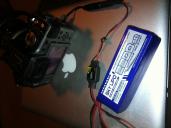
-
Something I made for myself because I got sick of Panasonic rolling out the pathetic 1700mha that cannot handle high dis-charge rates.
The battery was originally for a high performace radio controlled car so it can handle high dis-charge rates. I used it only little but I have also added a LED so I can tell when its running low, which I think is a nice little touch when you are out shooting some cerleberties running away. -
As a follow up to my previous post where I wondered if the step-up/step-down module could be coupled with the 6400 mA li-ion bike battery, I'd like to report that I received them both, assembled them up and ... as a preliminary test I must say the whole thing seems to work.
In fact while connecting the battery straight to the camera it would give me the ugly "this battery cannot be used" warning, when I plugged in between the step-up/step-down module and adjusted the output voltage to 8.5 v, the camera did not complain anymore.
Now I only need to find out how long the power will last and how to properly recharge the battery.
Does anybody know if I can use the ordinary charger we use for the original batteries? The 6400 mA Li-Ion battery seems to be made by 4 18650 4.2v 3200 mA batteries connected in series and in parallel.
Thanks
-
I may be able to contribute here on how to lengthen battery life .. I have raced RC cars competitively for 6 years and have quite a good knowledge of looking after batteries and getting maximum life from them.
It's quite hitech .. we use tyre warmers .. peltiers on the motors before the race .. and traction compound where the venue allows it. We'll take the batterries off charge with 60 seconds to starting grid. My car hits a 128km/hr in 23 metres from a standing start .. it's 1/10 scale
I was around when NiMH were the battery choice and lipos were illegal and I raced through the transition to lipo. During a race, depending on which motor is used an RC car can flatten a 5300mAH lipo in under 5minutes.
The high power levels accelerate the decline in battery life. What follows applies to the relatively low consumption that our rigs require.
As no two cells are identical, with a 6 cell NiMh pack as it supplies current, each battery discharges a different rate. (FYI the cells are 1.2volts). If you use the type of charger where you connect +ve to one end of the pack and -ve to the other. The charger decides what to do based upon the total voltage measure across the 6 cells. remember they have discharged at a different rate. After multiple discharge and charge cycles you end up with the situation where some cells are overcharged and others are undercharged, at some point a cell in the pack will either be cooked through overcharging or excessive discharge.
To prevent this we used dischargers, which takes every cell down to .9 volts generally pulling about 20 Amps, and then we use a chargers which charge each cell individually .. as I progressed upwards in motor power and speed .. I was chewing through 4 battery packs every 10 weeks (we have 4 races per week each) at about $120 a pack. I was buying matched cells which cost a fair bit more but last a lot longer, even if you don't handle them correctly.
Discharging each cell independently is more important than charging each cell individually. http://www.camlight.com/techinfo/whydischarge_4.html
This is why many batteries and chargers have multiple pins for example the old NP1s. A quality charger will discharge to .9v before charging.
It's similar but different with lipos .. while they don't require discharging .. they do require that all cells are charged to the same level .. or you end up with one undercharged cell and one overcharged cell. And once a lipo cell drops below .. 2.6 volts I think (the principle is hopefully clear) .. it's dead .. the next time you charge it .. it will swell up and eventually cause the good cell to burst inot a fireball.
You will find two types of lipos .. those with only a +ve and a -ve and those with a tap for each cell.
To maximise life of lipos .. buy batterys with the tap and you need a charger that charges each cell individually.
I hope this is of assistance to some .. remember no two cells are identical. Buy a quality battery and chances are the cells will be more closely matched.
That said sometimes I abuse the batteries deliberately .. If I was chasing trophy, I'd overcharge a pack to get that extra speed off the start and lead into the first turn.
-
Well I took the plunge and ordered both. It'll take almost a month to get them, but I'll report as soon as I test them.
-
Yeah that should work I don't really know enough about Boost Bucks. I was under the impression that it is more efficient to just step down voltage than step up. But I really don't know enough about it to know if it even makes any difference in real world battery performance.
-
But if I want to use the 8.4v 6400 mA battery and the 3.5-28V to 1.25-26V DC-DC Converter Boost Buck Step Up Step Down Voltage Module, shouldn't such module guarantee that the voltage does NOT drop?
-
I would try for something with slightly higher voltage and then use some sort of stabilizer to get the 9v you need. I am thinking about this one for my next battery http://www.hobbypartz.com/77p-sl4000-3s1p-40c-3333-hardcase.html and using a 9v ubec to step the voltage down. Trying to find a cheap battery buzzer/light so that I can mount it to keep track of the voltage. I have a cheap one that goes on the balance tap but it is kinda annoying and don't think I want it on my rig permanently.
-
So shall we dismiss such alluring battery pack?
-
@feha, thats sounds about right, long live the battery packs of dry cell lol
-
@feha , thanks for the tip!
-
@rockroadpix just to let you know the 8.4v can be to little for GH2, count with voltage drop, than it may show the message powering error, when you press record. I practice to use 8.6 v ...
-
It doesn't suck that it has or can have the little velcro bag ...might be good for putting on the rods.
-
@rockroadpix, this an interesting battery that I have come across before. I might look into it to see if its a good stable voltage for the GH2. Might be the best battery yet.
-
Ran that setup today for about 3 hours. Worked well but the only thing that was interesting was that if the battery was plugged in but the camera not on the UBEC got pretty warm. So I am thinking it needs a switch or something to keep current from the UBEC when the camera is off but the battery is plugged it.
-
@itimjim yeah I was somewhat worried until I tested the output from the UBEC and it didn't waver even the slightest bit. Real solid little part.
-
Would this battery be a good possibility? I like the size...
-
@tommyp I bet that was a twitchy arse moment :-D
-
Just received my 9v UBEC and wired it up. I have a voltage display somewhere I have to wire in but the UBEC puts out a super stable 9v and the camera works perfectly.

 photo(6).JPG2592 x 1936 - 2M
photo(6).JPG2592 x 1936 - 2M -
@feha, its an intersting idea were you could have a big battery and drop the voltage so its par with the camera.
-
The list of links is on youtube video description ... The cost depends from what components you want to buy ... minimum: Step Up Step Down Voltage Module - about 8 GBP , 10pcs 5.5mm X 2.5mm DC Power Supply Metal Jack Socket - about 10 GBP and some wires , the alu box - about 12 GBP For the more advanced version the cost is a bit more, but still affordable ...
-
@feha, very interesting- How much does all this cost, It would be interesting to use a 12v nimh battery pack to power the camera. Allowing longer use out of it.
-
@feha thanks for getting the tutorial sorted :)
Howdy, Stranger!
It looks like you're new here. If you want to get involved, click one of these buttons!
Categories
- Topics List23,988
- Blog5,725
- General and News1,353
- Hacks and Patches1,152
- ↳ Top Settings33
- ↳ Beginners255
- ↳ Archives402
- ↳ Hacks News and Development56
- Cameras2,365
- ↳ Panasonic994
- ↳ Canon118
- ↳ Sony156
- ↳ Nikon96
- ↳ Pentax and Samsung70
- ↳ Olympus and Fujifilm100
- ↳ Compacts and Camcorders300
- ↳ Smartphones for video97
- ↳ Pro Video Cameras191
- ↳ BlackMagic and other raw cameras116
- Skill1,960
- ↳ Business and distribution66
- ↳ Preparation, scripts and legal38
- ↳ Art149
- ↳ Import, Convert, Exporting291
- ↳ Editors191
- ↳ Effects and stunts115
- ↳ Color grading197
- ↳ Sound and Music280
- ↳ Lighting96
- ↳ Software and storage tips266
- Gear5,420
- ↳ Filters, Adapters, Matte boxes344
- ↳ Lenses1,582
- ↳ Follow focus and gears93
- ↳ Sound499
- ↳ Lighting gear314
- ↳ Camera movement230
- ↳ Gimbals and copters302
- ↳ Rigs and related stuff273
- ↳ Power solutions83
- ↳ Monitors and viewfinders340
- ↳ Tripods and fluid heads139
- ↳ Storage286
- ↳ Computers and studio gear560
- ↳ VR and 3D248
- Showcase1,859
- Marketplace2,834
- Offtopic1,320










